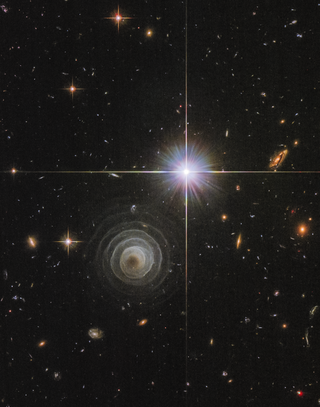LL Pegasi
|
Double star CRL 3068 / AFGL 3068 / LL Pegasi |
|||||
|---|---|---|---|---|---|

|
|||||
| Near infrared image from the Hubble Space Telescope . The bright object on the right is a star in the foreground that served as a guiding star for later examination by the larger Keck telescope. | |||||
| AladinLite | |||||
|
Observation dates equinox : J2000.0 , epoch : J2000.0 |
|||||
| Constellation | Pegasus | ||||
| Right ascension | 23 h 19 m 12.61 s | ||||
| declination | + 17 ° 11 ′ 33.1 ″ | ||||
| Typing | |||||
| Spectral class | C. | ||||
| Variable star type | M. | ||||
| Astrometry | |||||
| distance | (1,300) pc | ||||
| Visual absolute brightness M vis | (−5.35) mag | ||||
| Proper movement | |||||
| Rec. Share: | (−5.69 ± 0.8) mas / a | ||||
| Dec. portion: | (−8.22 ± 0.8) mas / a | ||||
| Physical Properties | |||||
| radius | (600 to 900) R ☉ | ||||
| Luminosity |
(11000) L ☉ |
||||
| Effective temperature | (2000) K. | ||||
|
Other names and catalog entries |
|||||
|
|||||
CRL 3068 / AFGL 3068 / LL Pegasi is a binary star system surrounded by a spiral nebula in the constellation Pegasus . The two stars were identified through observations from the Keck Observatory . Their apparent distance is 0.11 ″. The cause of the spiral structure is assumed to be the matter emission of one of the two stars (a carbon star ), which is modulated by the mutual orbiting. An orbital period of 710 years was calculated based on the spiral distance and the outflow velocity.
Since both stars are covered by a cloud of dust that is only permeable in the infrared and could not be separated when creating the IRAS directory due to the small distance, they are listed there with a common designation and position.
Web links
Commons : LL Pegasi - collection of images, videos and audio files
- Florian Freistetter: A dying star and a cool spiral , 2010
- ESO: Heavenly spiral with one twist
- astronews.com: Picture of the day June 4, 2012
- An Extraordinary Celestial Spiral
- Celestial spiral goes viral
- Hubble Spots Ghostly Space Spiral
- An Extraordinary Spiral from LL Pegasi , APOD
Individual evidence
- ↑ a b RAFGL 3068. In: SIMBAD . Center de Données astronomiques de Strasbourg , accessed September 9, 2018 .
- ↑ a b LL Peg. In: VSX. AAVSO, accessed September 9, 2018 .
- ↑ a b c R. Lombaert, BL De Vries, A. De Koter, L. Decin, M. Min, K. Smolders, H. Mutschke, LBFM Waters: Observational evidence for composite grains in an AGB outflow. MgS in the extreme carbon star LL Pegasi . In: Astronomy & Astrophysics . 544, 2012, p. L18. arxiv : 1207.1606 . bibcode : 2012A & A ... 544L..18L . doi : 10.1051 / 0004-6361 / 201219782 .
- ↑ Guandalini, R., Cristallo, S .: Luminosities of carbon-rich asymptotic giant branch stars in the Milky Way . In: Astronomy & Astrophysics . 555, 2013, p. 7. arxiv : 1305.4203 . A120. bibcode : 2013A & A ... 555A.120G . doi : 10.1051 / 0004-6361 / 201321225 .
- ^ A b c E. De Beck, L. Decin, A. De Koter, K. Justtanont, T. Verhoelst, F. Kemper, KM Menten: Probing the mass-loss history of AGB and red supergiant stars from CO rotational line profiles . II. CO line survey of evolved stars: Derivation of mass-loss rate formulas . In: Astronomy and Astrophysics . 523, 2010, p. A18. arxiv : 1008.1083 . bibcode : 2010A & A ... 523A..18D . doi : 10.1051 / 0004-6361 / 200913771 .
- ↑ Mark Morris, Raghvendra Sahai, Keith Matthews, Judy Cheng, Jessica Lu, Mark Claussen, Carmen Sánchez-Contreras: A Binary-Induced Pinwheel Outflow from the Extreme Carbon Star, AFGL 3068 (PDF; 145 kB)
